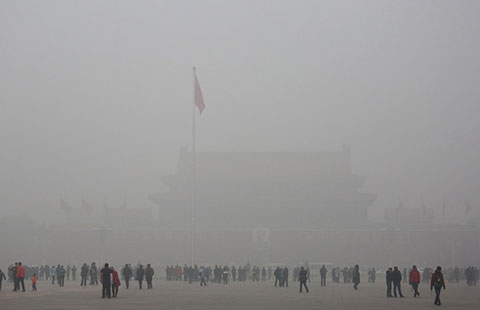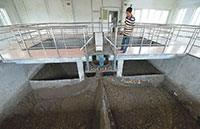China at cutting edge of dark matter search
By CHENG YINGQI (chinadaily.com.cn) Updated: 2015-12-17 19:50China is joining the global competition at the scientific frontier — the search for dark matter — and new research instruments and facilities are in place to heighten anticipation for answers.
On Thursday, the Chinese Academy of Sciences launched the country's first dark-matter satellite, which will be in service for three years searching for signs of dark matter, to study the origin of cosmic rays and to observe high-energy gamma rays.
"We hope we are lucky enough to become the first team in the world to find dark matter," said Chang Jin, deputy director of the academy's Purple Mountain Observatory. "Even if we are not, we will discover something new with this advanced probe."
Dark matter is extremely difficult to measure because it seldom interacts with anything, beyond generating gravity. Most researchers trying to measure it using electronic or magnetic signals have reached a dead end.
However, Chang believes that when dark matter particles collide and annihilate each other, they generate particles that can be detected — electrons, antiproton and gamma rays. He proposed the idea when he joined the Advanced Thin Ionization Calorimeter project sponsored by NASA, the United States space agency, in 1998.
Between 2000 and 2003, the team launched a balloon-borne instrument over Antarctica to detect comic rays at low altitudes. It found excess electrons that may have been emitted by dark matter annihilations somewhere in space, perhaps 3,000 light years from Earth.
The discovery was reported by the journal Nature in 2008, as exciting indirect evidence for the existence of dark matter.
After the initial success, Chang proposed launching a dark matter satellite — one with more advanced detectors and higher resolution — in space rather than in the atmosphere above Antarctica. In space there is stronger cosmic radiation and less interference.
"The indirect evidence can give us a glimpse into dark matter, just as we can infer the nature of a father by seeing his son," Chang said.
Besides the attempt to find indirect evidence, Chinese scientists are carrying out parallel experiments to find direct evidence.
In 2010, the China Jinping Underground Laboratory — an dark matter laboratory beneath 2,400 meters of rock — was put into operation by two groups of experimenters: the International project PandaX led by Shanghai Jiao Tong University, and CDEX from Tsinghua University.
Using approaches different from that of astrophysicists, these groups try to observe dark matter directly instead of tracing it via the particles emitted during annihilation events.
- Year's worst smog coming to north China
- China launches satellite to shed light on invisible dark matter
- China strongly opposes US arms sale to Taiwan
- Report: Layoffs may loom next year
- Pandas prefer choosing their own sex partners, researchers find
- Cyberspace door stays open, says watchdog chief
- China to spend $93b relocating 10 million people
- PM2.5 emission should be cut by half to meet national standard
- How Internet turned remote Wuzhen into smart global city
- Big cities in China luring talent despite drawbacks







